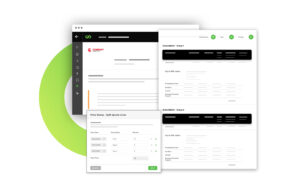Structured Ramp Pricing Eliminates Approval Guesswork

Approving multi-year deals shouldn’t require rebuilding quotes in spreadsheets. Ramp pricing in CPQ structures discounts, pricing changes, and SKUs across defined periods, giving Finance and Deal Desk full visibility into margins, forecasts, and revenue recognition—without rework.
Why Multi-Year Deals Are a Nightmare to Approve
Long-term deals often look simple—until Finance or Deal Desk digs in:
- Year 1 has deep discounts
- Year 2 jumps in price
- Year 3 introduces new SKUs or add-ons
- A promotional offer is buried in footnotes
To approve revenue and protect margins, you need clarity. Without structured pricing logic, you’re left with:
- Disconnected line items to simulate ramps
- No clear margin breakdown across periods
- Manual edits that don’t align with CRM or billing
- Approval decisions based on guesswork, not confidence
The result? Deals get blocked—or approved with crossed fingers.
The Core Problem: Long-Term Deals Lack Transparency
Multi-year contracts often rely on manual edits and unstructured quotes, creating:
- Inconsistent margin evaluation across time
- Untraceable pricing logic that’s hard to audit
- Forecasts that don’t match reality
- Risk in revenue recognition and compliance
When quotes are stitched together manually, Finance and Deal Desk carry the risk of approving deals they can’t fully validate.
How Structured Ramp Pricing Fixes the Problem
Embedding ramp pricing into CPQ eliminates manual guesswork and standardizes deal structure:
- Each SKU is structured across defined time buckets
- Pricing changes and discounts are applied per period with rule-based logic
- Total value and margin visibility update automatically
- Quote, forecast, and billing data stay perfectly aligned
You don’t need to rebuild the quote to approve it—you can trust what you see.
What Finance and Deal Desk Gain
- Faster approvals with full visibility into pricing ramps
- More consistent margin evaluation across all periods
- Clear documentation for audits and revenue recognition
- Seamless handoff to billing and contracts with no reconciliation needed
Structured pricing turns approval from a manual risk into a scalable, repeatable process.
Manual Approval vs CPQ Ramp Pricing
Feature | Manual Multi-Year Deal Approval | CPQ Ramp Pricing |
Margin Visibility | Low, requires manual calculation | High, automated by period and SKU |
Pricing Consistency | Dependent on rep edits | Rule-based and structured |
Approval Speed | Slow, prone to back-and-forth | Fast, with full confidence |
Revenue Recognition Accuracy | Risky and error-prone | Accurate and audit-ready |
Forecast & Billing Alignment | Often mismatched | Perfectly synced across systems |
Frequently Asked Questions (FAQs)
What is ramp pricing in CPQ?
It’s a structured way to model multi-year deals with pricing changes and discounts by period, ensuring accurate margin and revenue visibility.
Why do manual multi-year quotes create approval risk?
They rely on disconnected line items and untraceable calculations, making margin evaluation and forecasting unreliable.
How does ramp pricing improve deal approvals?
It provides structured, rule-driven logic that Finance and Deal Desk can validate instantly, reducing delays and risk.
Can ramp pricing improve revenue recognition?
Yes. With clear period-based pricing, billing and revenue schedules align automatically, simplifying compliance and audits.
What’s the impact on approval speed?
Approvals are significantly faster because Finance no longer needs to rebuild deals to validate margins or logic.
Related Posts

Price Ramping Maximizes Lifetime Value with Scalable Pricing
Price Ramping Maximizes Lifetime Value with Scalable Pricing Instead of locking customers into flat rates, Price Ramping lets you build subscription contracts that grow over time. By aligning pricing with customer value and usage maturity, you remove friction from deal closure while expanding revenue predictably. This feature is crucial for

Stop Training Reps on Product Rules—Let CPQ Do It For You
Stop Training Reps on Product Rules—Let CPQ Do It For You Reps Shouldn’t Memorize Product Rules—They Should Sell If you’re constantly teaching reps what they can’t quote, you’ve got a tooling issue—not a training one. With CPQ product rule automation, reps quote faster, avoid errors, and learn configurations as they

Renewal Based Upselling Turns Every Contract into a Growth Moment
Renewal Based Upselling Turns Every Contract into a Growth Moment Most SaaS companies treat renewals as a checkbox—but that’s a missed revenue opportunity. Renewal-based upselling embeds upgrade options directly into renewal workflows, driving higher ACV, better customer satisfaction, and faster upsell cycles. The key? Use contextual visibility, pre-built upgrade paths,
Ready to fix leaks, speed up quoting, and unlock hidden revenue?
Use our RoI Calculator to see where your business can grow next.


